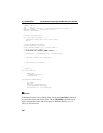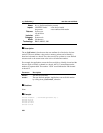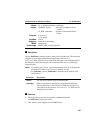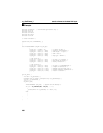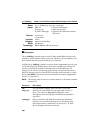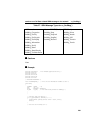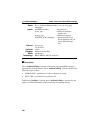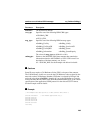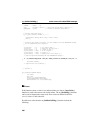
cc_SndMsg( ) sends a non-Call State related ISDN message to the network
260
Name:
int cc_SndMsg(crn, msg_type, sndmsgptr)
Inputs:
CRN crn
• call reference number
int msg_type
• ISDN message type
IE_BLK *sndmsgptr
• pointer to the information element
(IE) block
Returns:
0 on success
< 0 on failure
Includes:
cclib.h
Category:
Optional call handling
Mode:
synchronous
Technology:
BRI/2; BRI/SC; PRI (all protocols)
!
! !
!
Description
The cc_SndMsg( ) function sends a non-Call State related ISDN message to the
network over the D channel, while a call exists. The data is sent transparently over
the D channel data link using the LAPD (Layer 2) protocol.
For BRI, the cc_SndMsg( ) function is used to invoke supplemental services, such
as Called/Calling Party Identification, Call Transfer, and Message Waiting. The
services are invoked by sending Facility Messages or Notify Messages (see
Table 27) to the switch. Upon receipt of the message, the network may return a
NOTIFY message to the user. The NOTIFY messages can be retrieved by calling
the cc_GetCallInfo( ) function. For more information on invoking supplemental
services, see Appendix D.
NOTE:
The message must be sent over a channel that has a call reference number
assigned to it.
Parameter Description
crn:
The call reference number. Each call needs a valid CRN.
msg_type:
Specifies one of the ISDN message types listed in Table 27
below. The values for msg_type are defined in cclib.h.
Descriptions of the message types for DPNSS are provided in
Appendix C.
sndmsgptr:
Points to the buffer (IE_BLK) that contains the information
element(s) to be sent in the message. For a description of the
data structure used to send the IEs, see Section 6.6. IE_BLK.
See the Example code below for details.



